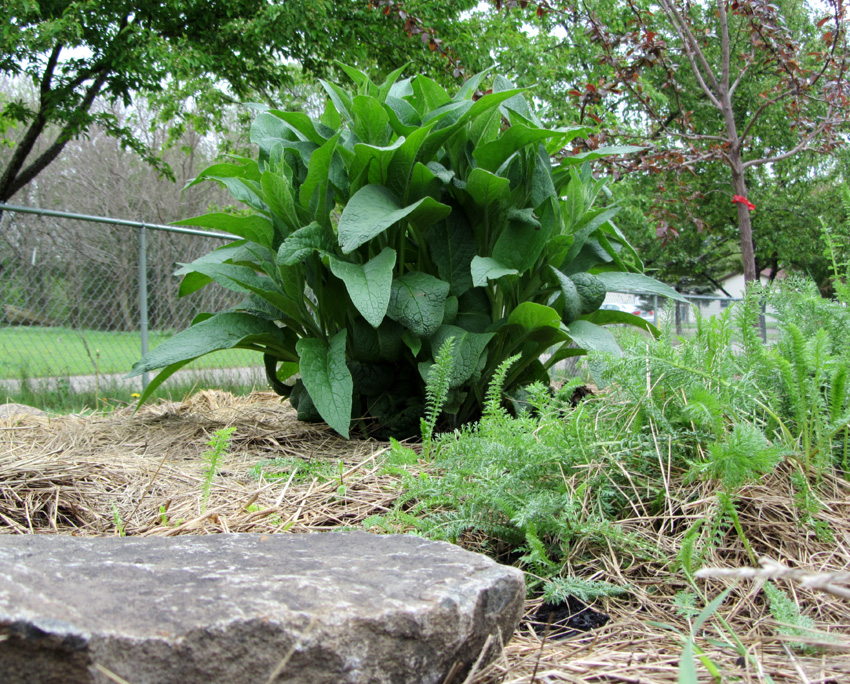If you’re looking for an easy and attractive plant to grow, give comfrey a try!
In the picture, the comfrey is the large, dark-leaved plant. The plant in front to the right is yarrow; behind is our Nichols plum tree.
Chris bought a few small roots of comfrey a couple years ago, and he has been splitting it and transplanting it ever since. It is incredibly hardy, one of the first things to come up in the spring – and very fast growing. It’s about the size now where it can be cut down and used as mulch. In another month, it will be this size again and ready for a second cutting.
We have a few of these planted in our apple guild – they have deep roots which help break up the soil, and are supposed to help by bringing up nutrients from deep in the earth for the other plants to feed on. Their leaves make great mulch, and they add a lot to the soil when composted.
You can see the size in comparison to our arbor and (still quite small) fruit trees. Comfrey is also planted between the new trees in front, and it should fill in by next spring.
From Wikipedia:
Comfrey as a compost activator – include comfrey in the compost heap to add nitrogen and help to heat the heap. Comfrey should not be added in quantity as it will quickly break down into a dark sludgy liquid that needs to be balanced with more fibrous, carbon rich material.
Comfrey liquid fertilizer – can be produced by either rotting leaves down in rainwater for 4–5 weeks to produce a ready to use ‘comfrey tea’, or by stacking dry leaves under a weight in a container with a hole in the base. When the leaves decompose a thick black comfrey concentrate is collected. This must be diluted at 15:1 before use.
Comfrey as a mulch or side dressing – a 2 inch layer of comfrey leaves placed around a crop will slowly break down and release plant nutrients; it is especially useful for crops that need extra potassium, such as fruit bearers but also reported to do well for potatoes. Comfrey can be slightly wilted before application optionally but either way, avoid using flowering stems as these can root.
Comfrey potting mixture – originally devised to utilize peat, now environmental awareness has led to a leaf mold-based alternative being adopted instead; two year old, well decayed leaf mold should be used, this will absorb the nutrient-rich liquid released by the decaying comfrey. In a black plastic sack alternate 3-4 inch layers of leaf mold and chopped comfrey leaves. Add a little dolomitic limestone to slightly raise pH. Leave for between 2–5 months depending on the season, checking that it does not dry out or become too wet. The mixture is ready when the comfrey leaves have rotted and are no longer visible. Use as a general potting compost, although it is too strong for seedlings.
Comfrey can also be used in a salve for treating wounds and other skin ailments, though we have not tried this.










I just planted my first comfrey plant, shortly after that I started getting the little green caterpillars eating them. I have just been picking them off but do you have any suggestions to control them, they’ve been on a couple other plants too.
On a side note I’m so glad that there is a fellow Anoka County permaculturist around. I’m just north of you in St.Francis. I don’t have much space for gardening so I’m always living vicariously through others, which is how I found you on the Permaculture Global website.
Nice to see a fellow “Sand Plain Gardener” 🙂
We’re not sure what your green caterpillars are…but sounds like cabbage moth worms. If you grow cabbage/broccoli you could check to see if they are on those too. I’ve read that dill helps keep cabbage moths away, so we let most of the dill that self-seeds in the garden just grow. You could try spraying on some diluted dish soap – I’ve also read cayenne pepper, but I’m not sure if that’s for the caterpillars or the rabbits.
For cabbage moths, we found that the years we grew cole crops in bad/mediocre soil, the plants were destroyed by the caterpillars. Once we started adding compost, the plants grew faster and even though they still get eaten by them and have a few holes, they do really well. Seems like the stronger plants are able to cope with the insect attacks much better.
We’ve never had a problem with pests on the comfrey at all – so I’m not sure what’s eating yours! Good luck!
Comfrey not toxic. Has been eaten as a veg & salad addition forever in the past. Great health benefits from its use. Find the book ” Comfrey past, present & Future’ by Lawrence D. Hills or “Comfrey – Natures Healing Herb & Health Food” by Andrew Hughes. or “How can I use Herbs in my everyday life” by Isabel Shippard. Comfrey has been demonized because pharmaceutical co’s. can’t patent nature, & comfrey has always worked. It used to be called ‘Saracen’s root – All heal – Wound wort – Knit bone’ & more. Educate yourself, you have in your garden one of natures most powerful tools for amazing good health. For both you & your animals. Please don’t believe the bad press, it was manufactured in the 1970’s & 80’s, to scare people off using it.